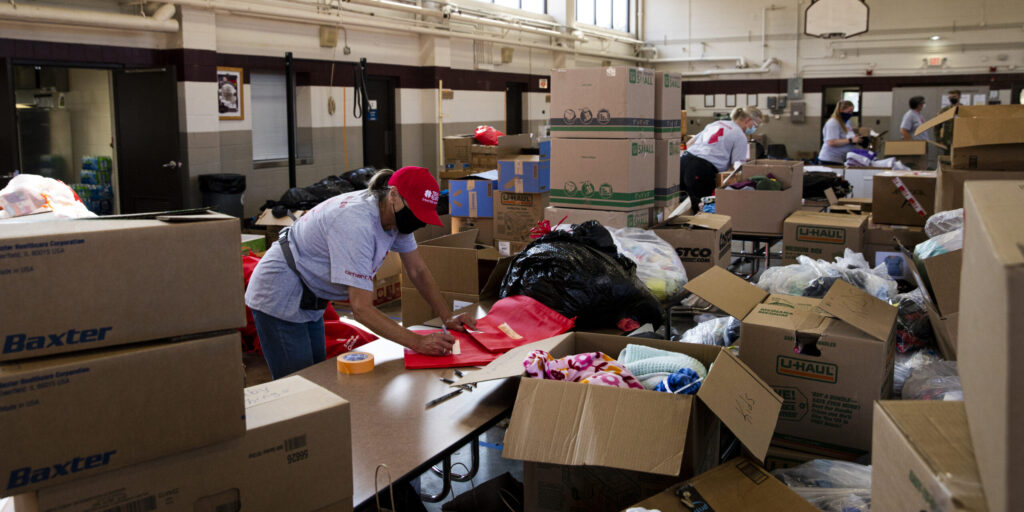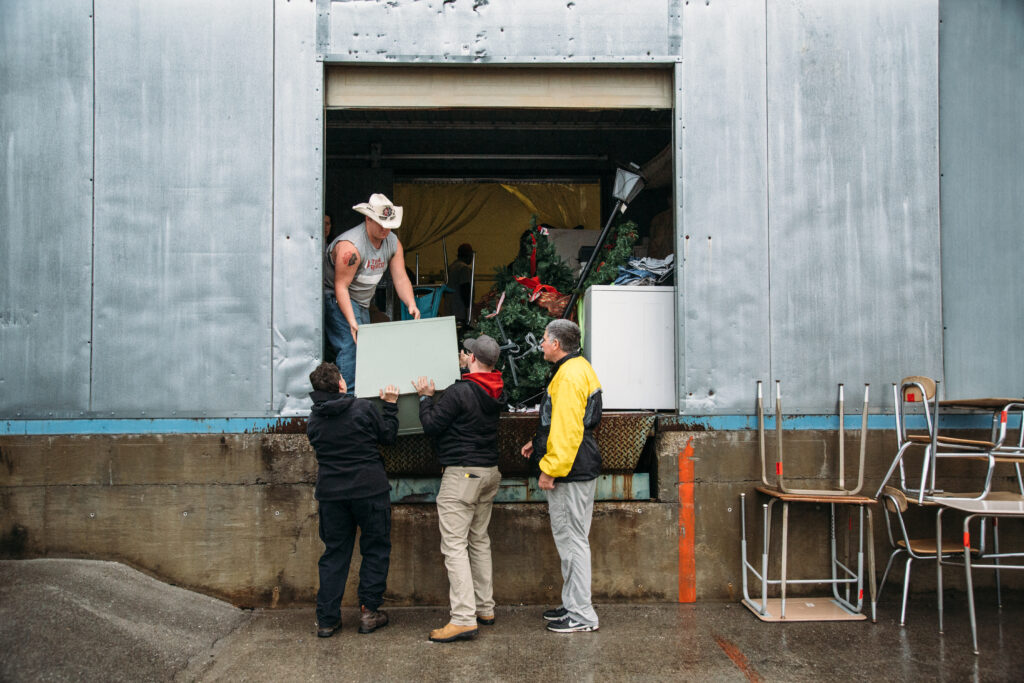It was September of 2024, and torrential rainfall from the remnants of Hurricane Helene was plowing into North Carolina. It came on the heels of slow-moving showers and a stalled cold front that was already dumping on the region. Stream flows were at record highs. Soon, the Watauga River near Boone, the Catawba River near Charlotte, and the French Broad and Swannanoa Rivers, which merge in Asheville, were at flood stage—and rising. When they peaked—three of them 15 to 21 feet above flood stage—they swamped houses and businesses and swept entire homes downriver.
Even before the floodwaters receded another disaster had begun: Random supplies were flooding into Asheville with no one to accept, sort, or distribute them, and with no place to store them. I heard about it firsthand, on a call with Charlotte-area business leaders recounting what they were hearing from colleagues in impacted areas. These business leaders were actively collaborating with local organizations and working together to formulate a thoughtful, collaborative strategy to receive and distribute donations that would appropriately meet the needs of Western North Carolina—including Asheville. As they did, they were also searching for a 1 million square foot warehouse to store all the stuff coming the city’s way. All best practices to be replicated, for sure, and yet this flood of unsolicited goods threatened to cause the second disaster.
Creating a Dumping Grounds in the Disaster Zone
Such donations to disaster-struck communities from individuals and businesses are always given from the heart and with the best of intentions. Yet while good intentions may fuel the everyman to donate physical goods during times of “great need,” increasingly such donations create what is known as the second disaster. When people send unwanted, incorrect, or unusable goods to a disaster zone, they create a dumping zone: A secondary crisis that will have to be solved by unknown someones, of unknown skillsets, with little to no expertise or the infrastructure to support, all while navigating the crisis at hand. This cruel cycle is repeated after every tragedy, every disaster that pulls at nationwide heartstrings.
Take for example when the winter coats began arriving in Houston in August of 2017. It was hot and sticky, and across the city more than 32,000 people had been forced out of their homes and into temporary shelters by Hurricane Harvey, which had dumped an estimated 1 trillion gallons of rain on Harris County in just four days. Outside of the disaster zone, compassionate Americans eager to help had begun giving what they believed to be of most use, sometimes with financial gifts but often with donated goods—including the winter coats, in a month when the city’s average high-temperature hovers above 94 degrees. Coats weren’t what the city’s residents needed, but they continued to arrive until, months later, they mounded on pallet after pallet to fill a warehouse to its brim, ultimately going unused. Thousands of donors’ well-intended impact became a logistical nightmare for community organizations and relief volunteers who could have been focused instead on the emergent needs of a ravaged city.

Or, take the broken refrigerators, dirty clothing, and diapers sent to Afghan refugee and welcome centers in 2022 and 2023.
“During the Afghan Refugee crisis, we got pallets and pallets of diapers. The problem was the Afghans don’t use diapers for their kids, so these things just piled up in the warehouse until we could find a place to offload them,” said Drew Hanna, Director of Branch Operations for Team Rubicon.
It’s a situation Hanna also witnessed while responding to the 2016 Great Smoky Mountains wildfires with Team Rubicon.
“After the Gatlinburg fire, the parking lot of our forward operating base was an informal dumping ground. There were two big pallets full of clothes—not useful clothes, but weird things like fur coats and high heels and bathing suits,” says Hanna. “These pallets sat, uncovered and unclaimed, for weeks, through all kinds of weather.”
Gifts From a Place of Compassion Go to Rot and Create the Second Disaster
At their best, in-kind donations—goods and services donated in lieu of money—provide a community with supplies that couldn’t be acquired otherwise, and help nonprofits like Team Rubicon stretch their donor dollars. At worst, and in most cases, they inundate a community with items that can’t be used or, in the case of food donations, go to rot. Thus, the second disaster begins.
While in-kind donations come from a place of compassion and a desire to help from afar, the challenge with unsolicited donated goods is often that what may be essential in the moments after a disaster can become useless or overwhelming just days later. Sometimes, the donations were simply not what was needed. Other times, a much-needed supply arrived on the heels of thousands of duplicate donations.
Hard-earned money from real people was used to buy these supplies, only for them to rot. Certainly, that was never the intention of the donor. No one wants their good intentions to turn to bad, yet when an individual sends their “stuff” to a disaster zone without knowing exactly what is needed, how it will be sorted, stored, or distributed, or what will happen if it can’t be used, they are placing an additional undue burden on the very communities and disaster survivors they think they are helping.
A Complex Problem, and a Simple Solution
The solution to the crisis of creating waste in a disaster zone, and wasting donors’ hard-earned money, is simple: Give cash—not goods—in the immediate wake of the disaster.
Individuals and organizations can better serve disaster survivors and ensure the donor’s hard-earned money is spent on the specific kinds of goods and supplies survivors absolutely need, in the moment they need them, by donating cash to the nonprofit organizations that distribute those goods to survivors, or who purchase the supplies needed to restore homes damaged in disasters.

Funding allows trustworthy organizations in the immediate disaster zone the ability to use in-the-moment knowledge to source and distribute the goods and to address survivors’ situations acutely and more effectively. The ability to purchase supplies needed in the minute also eliminates costly storage and shipping costs for warehoused supplies and the enormous logistical hurdles unsolicited, unprescribed, uncoordinated supplies also bring. Most importantly this provides the exact need for that survivor and that community at the exact moment it was necessary.
While disaster survivors and the nonprofits that serve them are incredibly grateful for the intention behind every donation made in a crisis, those who want to ensure their hard-earned dollars deliver the exact items that are needed by disaster survivors, at the exact moment they are needed, and aren’t wasted should donate cash, not things. If we are to best serve the growing number of people and communities burdened by an escalating volume of disasters, it’s time for Americans to halt the practice of sending stuff to disaster zones, and instead donate dollars directly to survivors and the vetted, reputable local and national nonprofits serving them.



